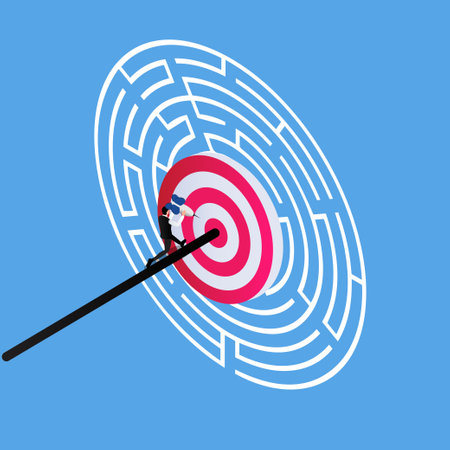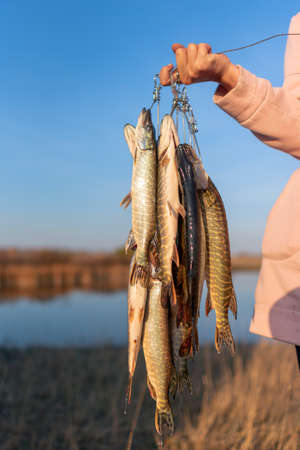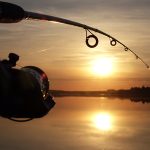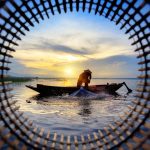Understanding Bass Behavior in Summer
When summer hits and temperatures rise, bass behavior shifts in noticeable ways. Understanding these changes is key to targeting bass effectively during the warmer months. As water temperatures climb, bass metabolism speeds up, driving them to feed more frequently—but it also means they become more selective about where and when they eat.
How Temperature Affects Bass Metabolism
Bass are cold-blooded creatures, so their body temperature matches their environment. In summer, as water warms up, their metabolism increases. This means they need more food to maintain energy levels. However, hotter water also holds less oxygen, which can make bass sluggish during the hottest parts of the day.
Water Temperature vs. Bass Activity
| Water Temperature (°F) | Bass Activity Level | Feeding Behavior |
|---|---|---|
| 60–70°F | Moderate | Active feeding, especially mornings and evenings |
| 70–80°F | High | Aggressive feeding periods throughout the day |
| 80–90°F+ | Low to Moderate | Selective feeding, mostly early morning and late evening |
Summer Feeding Patterns
During summer, bass tend to feed during low-light hours—early morning, late evening, or even at night. Midday sun and high heat push them into deeper or shaded areas where the water is cooler and oxygen levels are higher.
Habitat Preferences in Hot Weather
Bass adjust their location based on comfort and food availability. Look for them in places like:
- Deep structure: Ledges, drop-offs, and underwater humps provide cooler temps.
- Shaded cover: Overhanging trees, docks, and thick vegetation offer relief from the sun.
- Moving water: Areas with current like creeks or river channels have more oxygen.
Common Summer Bass Hideouts
| Location Type | Why Bass Like It |
|---|---|
| Docks & Overhangs | Shade and ambush points for baitfish |
| Main Lake Points & Drop-offs | Access to deeper, cooler water nearby |
| Lily Pads & Grass Mats | Covers from sunlight; good frog fishing spots |
The key takeaway is that summer bass are still active—they just behave differently. Knowing how temperature impacts their biology helps you choose smarter spots and times to fish.
2. Best Times of Day for Summer Bass Fishing
When the summer sun is blazing and temperatures soar, bass tend to become sluggish during the hottest parts of the day. To boost your chances of landing more fish, its crucial to focus on the times when bass are most active—and thats usually early in the morning, late in the evening, or even at night.
Early Morning: The First Light Bite
Right before and just after sunrise is one of the best windows to catch active bass. During this time, water temperatures are cooler, oxygen levels are higher, and baitfish are moving near the surface. Bass take advantage of these conditions to feed aggressively.
Tips for Morning Fishing:
- Use topwater lures like poppers, frogs, or buzzbaits near weed lines or shallow structure.
- Look for shaded areas along banks or under docks where bass may be lurking.
- Fish quietly—early morning bass can be easily spooked by loud noises or boat movement.
Evening: The Golden Hour
The hour leading up to sunset offers another excellent opportunity to target summer bass. As the sun drops lower in the sky, water temps begin to cool again, encouraging bass to leave deeper cover and hunt for food.
Tips for Evening Fishing:
- Switch between topwater and slow-moving baits depending on activity level.
- Fish points, drop-offs, and transitions from deep to shallow water.
- Watch for surface action—bass chasing baitfish often gives away their location.
Nighttime: Beating the Heat
If you’re comfortable fishing after dark, nighttime can be surprisingly productive during summer months. With less boat traffic and cooler temperatures, big bass often come out to feed under the cover of darkness.
Tips for Night Fishing:
- Use dark-colored lures like black spinnerbaits or worms that create vibration and contrast.
- Focus on known structure like submerged logs, rocky points, or bridge pilings.
- Bring a headlamp or lantern—but keep lighting minimal to avoid spooking fish.
Quick Guide: Best Times & Techniques
| Time of Day | Bass Activity Level | Recommended Lures | Tactics |
|---|---|---|---|
| Early Morning | High | Poppers, Frogs, Buzzbaits | Target shallow cover; use topwater presentations |
| Evening | Medium to High | Craws, Crankbaits, Topwaters | Fish transition zones; vary retrieve speeds |
| Nighttime | Moderate (Big Bass Potential) | Dark Spinnerbaits, Worms | Work slow and steady around structure; rely on vibration and profile |
Selecting the right time of day can make a huge difference when targeting bass in the summer heat. Focus your efforts during low-light periods to increase your chances of hooking into active fish while avoiding peak heat hours.

3. Go-To Locations: Where Bass Hang Out When Its Hot
When summer heat kicks in, bass don’t just disappear — they relocate to areas that offer comfort and easy access to food. Knowing where to look is half the battle when targeting bass during the dog days of summer. Here are some proven hotspots you should focus on when the temperatures rise.
Deep Structures
As surface temperatures soar, bass often move deeper where the water is cooler and oxygen levels remain stable. Key deep-water structures include:
- Drop-offs: Sudden changes in depth near ledges or channels.
- Underwater humps: Submerged high spots can attract baitfish and, in turn, bass.
- Main lake points: These provide easy access to both shallow and deep zones.
Shaded Cover
Bass love shade during hot summer days. It offers protection from the sun and ambush opportunities for feeding. Look for:
- Docks with overhead cover
- Lily pads and overhanging trees
- Marina slips and boat houses
Grass Lines
Aquatic vegetation is a summer magnet for both baitfish and bass. Grass provides cover, cooler water, and oxygen. Target:
- Edges of hydrilla or milfoil beds
- Pockets within thick vegetation
- Matted grass with open water nearby
Current-Fed Areas
Bass are drawn to moving water during summer because it brings in oxygen and food. Whether youre fishing rivers or reservoirs, these areas can be goldmines:
- Mouths of creeks or inlets
- Narrows between main lake sections
- Dams or spillways with consistent flow
Quick Reference Table: Summer Bass Hotspots
| Location Type | Description | Bass Behavior |
|---|---|---|
| Deep Structures | Ledges, humps, points | Migrate deeper for cooler temps and stability |
| Shaded Cover | Docks, trees, lily pads | Avoid direct sunlight; ambush prey |
| Grass Lines | Aquatic vegetation edges & mats | Shelter, oxygen, bait concentration |
| Current-Fed Areas | Creak mouths, narrows, dams | Sit in current breaks; wait for food flow |
The key to successful summer bass fishing is adapting to their seasonal behavior. By focusing your efforts on these proven locations, youll greatly increase your chances of finding active fish even on the hottest days.
4. Top Lures and Tactics That Work in the Heat
When summer temperatures rise, bass behavior changes — and so should your bait selection. Understanding which lures work best in the heat can help you consistently put fish in the boat. Here’s a breakdown of some go-to options and how to use them effectively when chasing bass during those hot summer days.
Topwater Lures for Early Mornings and Evenings
During low light periods like dawn and dusk, topwater baits shine. The cooler water temps at these times make bass more active near the surface. Try walking baits, poppers, or buzzbaits to draw explosive strikes.
Recommended Topwater Options:
| Lure Type | Best Conditions | Retrieve Tips |
|---|---|---|
| Walking Bait (e.g., Zara Spook) | Calm mornings/evenings | “Walk-the-dog” side-to-side motion |
| Poppers | Slightly windy conditions | Short pops with pauses in between |
| Buzzbaits | Weedy areas or over submerged grass | Steady retrieve across the surface |
Soft Plastics for Midday Pressure
When the sun is high and bass head for cover, soft plastics are your best friend. Texas-rigged worms, creature baits, and stickbaits can be flipped into heavy cover or dragged along the bottom to entice lethargic fish.
Effective Soft Plastic Setups:
- Texas Rig: Great for fishing through weeds and brush piles without getting snagged.
- Ned Rig: Ideal for finesse presentations when bass are less aggressive.
- Wacky Rig: Perfect for skipping under docks or into shaded pockets.
Crankbaits to Cover Water Quickly
If youre trying to locate active fish, crankbaits are excellent search tools. In warmer water, use medium- to deep-diving crankbaits that mimic shad or bluegill — two common summertime forage species.
Crankbait Tips:
- Choose diving depth based on where bass are holding (e.g., 10–15 feet during midday).
- Bounce off structure like rocks or stumps to trigger reaction bites.
- Use natural colors in clear water; go bold in stained water.
Jigs for Structure and Shade
Bass love shade in summer, especially around docks, laydowns, and ledges. Jigs excel at probing these areas thanks to their versatility. Use flipping jigs in shallow cover or football jigs on offshore structures.
Pro Tip:
Add a craw-style trailer to your jig for extra action that mimics fleeing prey.
Lure Selection Summary Table:
| Lure Type | Time of Day/Condition | Main Advantage |
|---|---|---|
| Topwaters | Dawn/Dusk, calm water | Surface strikes, exciting visuals |
| Soft Plastics | Noon/Midday, heavy cover | Subtle presentation for finicky fish |
| Crankbaits | Mornings/Afternoons, open water or drop-offs | Covers water quickly to find active fish |
| Jigs | All day, around structure/shade | Mimics crawfish or baitfish near cover |
Selecting the right lure based on time of day and water conditions is key when targeting bass in the summer heat. Rotate between these proven options until you find what triggers bites in your local waters.
5. Gear and Setup Tips for Hot Weather Conditions
When the summer heat kicks in, bass behavior changes—and so should your gear. Warmer water temperatures make bass more active and aggressive, which means your tackle needs to be up for the challenge. Heres how to fine-tune your rod, reel, line, and terminal tackle for hot weather bass fishing.
Rod and Reel Selection
During summer months, bass are likely to strike harder and fight stronger. Youll want a rod and reel combo that gives you both sensitivity and power.
| Component | Recommended Setup | Why It Works |
|---|---|---|
| Rod | 70″ to 76″ Medium-Heavy Fast Action | Gives you the backbone to set hooks hard while still detecting subtle bites |
| Reel | Baitcasting reel with 6.4:1 to 7.5:1 gear ratio | Allows quick retrieval when covering water or reeling in aggressive fish |
Line Choices for Summer Bass Fishing
Your line plays a big role in presenting baits naturally and handling strong runs. In warmer months, water clarity can vary and cover gets thicker, so choosing the right line is key.
| Line Type | Pound Test | Best Use Scenario |
|---|---|---|
| Braided Line | 30–50 lb test | For heavy cover like grass mats or lily pads—great for frogging or flipping jigs |
| Fluorocarbon Line | 12–20 lb test | Clear water or finesse applications where stealth is important—ideal for Texas rigs or crankbaits |
| Monofilament Line | 10–15 lb test | Topwater baits due to its buoyancy—good for poppers or walking baits in low-light conditions |
Terminal Tackle Adjustments for Summer Bites
The hot weather can make bass more aggressive but also more selective at times. Matching your hooks and weights to their behavior helps increase hookup ratios.
Hooks:
- EWG Worm Hooks (3/0 – 5/0): Great for soft plastics like creature baits or Senkos.
- Treble Hooks: Make sure they’re sharp if youre throwing crankbaits or topwaters—aggressive fish can still throw dull hooks.
- Offset Hooks: Ideal for Texas-rigging when fishing through thick vegetation.
Weights:
- Tungsten Weights: More compact than lead and more sensitive—perfect for feeling bottom structure during slower presentations.
- Nail Weights: Use them in stick baits for wacky rigging when bass go deep during midday heat.
- Pegged Bullet Weights: Help your bait penetrate thick cover faster during flipping or pitching.
Tuning Your Setup Based on Time of Day
| Time of Day | Tackle Adjustments | Bass Behavior Insight |
|---|---|---|
| Early Morning / Late Evening | Lighter line, topwater lures, slower presentations work well. | Bass are more active near the surface in cooler temps. |
| Noon / Midday Heat | Heavier gear, braided line, punch rigs or deep cranks. | Bass head deeper or into heavy cover to stay cool. |


